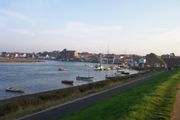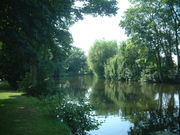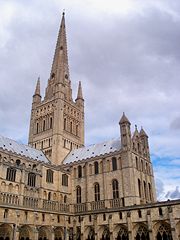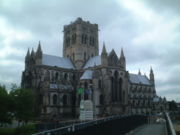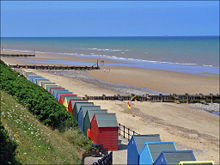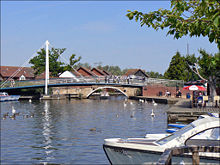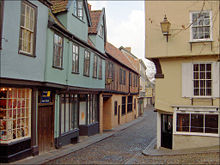Norfolk
2008/9 Schools Wikipedia Selection. Related subjects: Geography of Great Britain
| Norfolk | |
 |
|
| Geography | |
| Status | Ceremonial and Non-metropolitan county |
|---|---|
| Region | East of England |
| Area - Total - Admin. council |
Ranked 5th 5,371 km² (2,074 sq mi) Ranked 5th |
| Admin HQ | Norwich |
| ISO 3166-2 | GB-NFK |
| ONS code | 33 |
| NUTS 3 | UKH13 |
| Demography | |
| Population - Total (2006 est.) - Density - Admin. council |
Ranked 25th 832,500 155/km² (401/sq mi) Ranked 7th |
| Ethnicity | 98.5% white |
| Politics | |
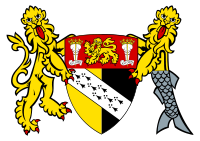 Arms of Norfolk County Council with supporters Norfolk County Council http://www.norfolk.gov.uk/ |
|
| Executive | Conservative |
| Members of Parliament | |
| Districts | |
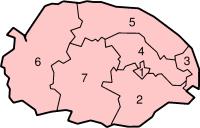
|
|
Norfolk (pronounced /ˈnɔrfək/) is a low-lying county in East Anglia, England, United Kingdom. It has borders with Lincolnshire to the west, Cambridgeshire to the west and southwest and with Suffolk to the south. Its northern and eastern boundaries are the North Sea coast, including The Wash. The county capital is Norwich, located at . Norfolk is the fifth largest ceremonial county in England, with an area of 5,371 km² (2,074 sq mi).
Of the 34 non-metropolitan English counties, Norfolk is the seventh most populous, with a population of 816,500. However, as a largely rural county it has a low population density, 152 people per square kilometre, making it 25th highest by population density. This is reflected in Norfolk's economy which is dominated by agriculture and tourism. The Broads lie partly within the county. A recent bid to have them declared a National Park failed, because it would have meant conservation being more important than navigation. Historical sites, such as the centre of Norwich, also contribute to tourism.
In a contest held by Plantlife, Norfolk's county flower was voted to be the Common Poppy after complaints that the first choice Alexanders was not representative.
History
Norfolk was settled in pre-Roman times, with neolithic camps along the higher land in the west where flints could be quarried. A Brythonic tribe, the Iceni, inhabited the county from the first century BC, to the end of the first century (AD). The Iceni revolted against the Roman invasion in 47 AD, and again in 60 AD led by Boudica. The crushing of the second rebellion opened the county to the Romans. During the Roman era roads and ports were constructed throughout the county and farming took place.
Situated on the east coast, Norfolk was vulnerable to invasions from Scandinavia and northern Europe, and forts were built to defend against the Angles and Saxons. By the 5th century the Angles, for whom East Anglia and England itself are named, had established control of the region and later became the "north folk" and the "south folk", hence, "Norfolk" and "Suffolk". Norfolk, and several adjacent areas, became the kingdom of East Anglia, later merging with Mercia and then Wessex. The influence of the Early English settlers can be seen in the many "thorpes", "tons" and "hams" of placenames. In the 9th century the region again came under attack, this time from Vikings who killed the king, Edmund the Martyr. In the centuries before the Norman Conquest the wetlands of the east of the county began to be converted to farmland, and settlements grew in these areas. Migration into East Anglia must have been high, as by the time of the Conquest and Domesday Book survey, it was one of the most densely populated parts of the British Isles.
During the high and late Middle Ages the county developed arable agriculture and woolen industries. The economy was in decline by the time of the Black Death, which dramatically reduced the population in 1349, suffice to say that the current population has yet to equal the population from this time. By the 16th century Norwich had grown to become the second largest city in England, but in 1665 the Great Plague of London again killed around one third of the population. During the English Civil War Norfolk was largely Parliamentarian. The economy and agriculture of the region declined somewhat, and during the industrial revolution Norfolk developed little industry and was a late addition to the railway network.
In the 20th century the county developed a role in aviation. The first development in airfields came with the First World War; there was then a massive expansion during the Second World War with the growth of the Royal Air Force and the influx of the American USAAF 8th Air Force which operated from many Norfolk Airfields. During the Second World War agriculture rapidly intensified, and has remained very intensive since with the establishment of large fields for cereal and oil seed rape growing. Norfolk's low-lying land and easily eroded cliffs, many of which are chalk and clay, make it vulnerable to the sea, the most recent major event being the North Sea flood of 1953.
The low-lying section of coast between Kelling and Lowestoft Ness is currently managed by the Environment Agency to protect the Broads from sea flooding. Management policy for the North Norfolk coastline is described in the North Norfolk Shoreline Management Plan which was published in 2006 but has yet to be accepted by the local authorities. The Shoreline Management Plan states that the stretch of coast will be protected for at least another 50 years, but that in the face of sea level rise and post-glacial lowering of land levels in the South East, there is an urgent need for further research to inform future management decisions, including the possibility that the sea defences may have to be realigned to a more sustainable position. Natural England have contributed some research into the impacts on the environment of various realignment options. The draft report of their research was leaked to the press, who created great anxiety by reporting that Natural England plan to abandon a large section of the Norfolk Broads, villages and farmland face to the sea to save the rest of the Norfolk coastline from the impact of climate change.
Economy and industry
In 1998 Norfolk had a Gross Domestic Product of £9,319 million, making it 1.5% of England's economy and 1.25% of the United Kingdom's economy. The GDP per head was £11,825, compared to £13,635 for East Anglia, £12,845 for England and £12,438 for the United Kingdom. In 1999-2000 the county has an unemployment rate of 5.6%, compared to 5.8% for England and 6.0% for the UK.
Much of Norfolk's flat and fertile land has been drained and converted to arable land. Chief arable crops are sugar beet, wheat, barley (for brewing) and oil seed rape. Over 20% of employment in the county is in the agriculture and food industries. Agribusiness has been successful in the county, and farming is very intensive with large fields, and many formerly family-run farms have been agglomerated into large farms which are highly efficient but criticised for reducing biodiversity, employment and damaging the community.
Well-known companies in Norfolk are Norwich Union, Colman's and Bernard Matthews. The Construction Industry Training Board is based on the former airfield of RAF Bircham Newton. The BBC East region is centred on Norwich (though covers as far west as Milton Keynes).
To help local industry in Norwich, Norfolk, the local council offers a wireless service.
Education
Primary and secondary
Norfolk has a completely comprehensive state education, with secondary school age from 11 to 16 or 18, as well as several private schools. In many rural areas, there is no nearby sixth form. Sixth form colleges are found in larger towns. There are twelve independent schools including the Gresham's School in Holt in the north of the county, and Norwich School, in Norwich. The Kings Lynn district has the largest school population.
Tertiary
The University of East Anglia is located on the outskirts of Norwich.
Politics
Norfolk is a shire county, under the control of Norfolk County Council. This is divided into seven local government districts, Breckland District, Broadland District, Great Yarmouth Borough, King's Lynn and West Norfolk Borough, North Norfolk District, Norwich City and South Norfolk.
The Department for Communities and Local Government has referred Norwich City Council's proposal to become a new unitary authority to the Boundary Committee. The Boundary Committee will report back by the end of the year.
Norfolk County Council is Conservative-controlled and led by Daniel Cox. There are 46 Conservative councillors, 22 Labour councillors, 14 Liberal Democrat councillors and two Green councillors. There was 63% turnout at the most recent local election.
In the House of Commons, Norfolk is represented by four Conservative Members of Parliament, three Labour MPs and one Liberal Democrat. Labour represent the more urban areas of Norwich and Great Yarmouth. The former Home Secretary, Charles Clarke, represents Norwich South.
| Parliamentary | County Council | ||||||||
|---|---|---|---|---|---|---|---|---|---|
| Party | Votes | Votes % | Seats | Seats % | Party | Votes | Votes % | Seats | Seats % |
| Conservative | 163224 | 40% | 4 | 50% | Conservative | 158942 | 39% | 46 | 55% |
| Labour | 122650 | 30% | 3 | 38% | Green | 18786 | 5% | 2 | 2% |
| Liberal Democrat | 103805 | 25% | 1 | 13% | Labour | 108043 | 27% | 22 | 26% |
| Others | 19371 | 5% | 0 | 0% | Liberal Democrat | 113048 | 28% | 14 | 17% |
| Others | 6924 | 2% | 0 | 0% | |||||
| Totals | 409050 | 8 | 405743 | 84 | |||||
| Turnout | 64% | 63% | |||||||
| Notes | |||||||||
|---|---|---|---|---|---|---|---|---|---|
|
Includes Town Close ward by-election held 26 May 2005, electors in Town Close didn't vote for a County Councilor on 5 May 2005 due to the death of one of the candidates between close of nominations and polling day. |
Settlements and communications
Norfolk's county town and only city is Norwich, one of the largest settlements in England during the Norman era. Norwich is home to Norfolk's only university, the University of East Anglia, and is the county's main business and culture centre. Other principal towns include the port-town of King's Lynn and the seaside resort and Broads gateway town of Great Yarmouth. There are also several market towns: Aylsham, Downham Market, Dereham, Fakenham, Diss, Holt, North Walsham, Swaffham, Thetford and Wymondham.
Norfolk is one the few counties in England that does not have a motorway. The A11 connects Norfolk to Cambridge and London and the A47 runs west to the East Midlands. The Great Eastern Main Line is a major railway from London Liverpool Street Station to Essex, Suffolk and Norfolk. The only major airport in the county is Norwich International Airport, which offers flights within Europe, including a link to Amsterdam which offers onward flights throughout the world.
Dialect, accent and nickname
The Norfolk Dialect, also known as "Broad Norfolk", is the accent/dialect of people living in Norfolk, although over the modern age much of the vocabulary and phrases have died out due to a number of factors, such as radio, TV and people from other parts of the country coming to Norfolk. As a result the speech of Norfolk is more of an accent than dialect, though one part retained from the Norfolk dialect is the distinctive grammar of the region.
More cutting, perhaps, was the formerly-used pejorative medical term " Normal for Norfolk", now discredited, the use of which is banned by the profession.
Tourist highlights
Norfolk is a popular tourist destination; major attractions include beaches, the Broads, and the city of Norwich. The Queen's residence of Sandringham provides an all year round tourist attraction. Rural parts of the county, notably the area around Burnham Market, are also popular locations for city dwellers to purchase weekend homes.
People of Norfolk
see also Category:People from Norfolk Some notable people who were born and/or raised in Norfolk:
- Peter Bellamy folk singer and musician, was born and brought up in North Norfolk
- Henry Blofeld, Cricket commentator
- Henry Blogg, the UK's most decorated lifeboatman, was from Cromer
- Boudica, queen of the Iceni people in ancient Britain and scourge of the occupying Roman Army, was born in the part of Norfolk that is close to Norwich, at a settlement near the River Wensum
- Sir Thomas Browne, English renaissance writer, physician and early archaeologist
- Martin Brundle, former motor-racing driver and now popular commentator was born in King's Lynn
- Dave Bussey Former BBC Radio 2 and current BBC Radio Lincolnshire presenter
- Howard Carter, archaeologist who discovered Tutankhamuns tomb. His childhood was spent primarily in Swaffham
- Edith Cavell, a nurse who aided the escape of prisoners in WW1
- Cathy Dennis, the singer and songwriter, from Norwich
- Diana, Princess of Wales, first wife of Charles, Prince of Wales, was born and grew up near Sandringham
- Anthony Duckworth-Chad, landowner and Deputy Lord Lieutenant of Norfolk
- Sir James Dyson, the inventor and entrepreneur, was born at Cromer, grew up at Holt and was educated at Gresham's School
- Nathan Fake, electronic dance music producer/DJ
- Natasha and Ralph Firman, racing drivers, were both born and brought up in Norfolk and educated at Gresham's
- Margaret Fountaine, the butterfly collector, was born in Norfolk, and her collection is housed in Norwich Castle Museum
- Elizabeth Fry, prominent 19th century Quaker prison reformer pictured on the Bank of England £5 note, born and raised in Norwich
- Stephen Fry, Actor, comedian, writer, producer, director and author. Was born in London and was brought up in the village of Booton near Reepham and also briefly attended Gresham's
- Samuel Fuller, signed the Mayflower Compact
- Claire Goose, the actress who starred in Casualty, was raised in Norfolk
- Sienna Guillory, the actress, from north Norfolk was educated at Gresham's School
- Ed Graham, drummer of Lowestoft band The Darkness, was born in Great Yarmouth
- Henry Rider Haggard, author
- Jake Humphrey, BBC presenter, spent most of his childhood in Norwich
- Andy Hunt footballer, grew up in Ashill
- Sid Kipper, Norfolk humourist, author, songwriter and singer
- Myleene Klass, former Hear'Say singer, hails from Gorleston
- Matthew Macfadyen, actor who starred in Spooks, was born in Great Yarmouth
- Ruth Madoc, actress, was born in Norwich
- Danny Mills, footballer, born in Norwich
- Lord Horatio Nelson, Admiral and British hero who played a major role in the Battle of Trafalgar, born and schooled in Norfolk
- Nimmo Twins, sketch comedy duo well-known in Norfolk
- Beth Orton, singer/songwriter, was born in Dereham and raised in Norwich
- Thomas Paine, philosopher, born in Thetford
- Barry Pinches, snooker player. comes from Norwich
- Matthew Pinsent, British rower, was born in Holt
- Philip Pullman, author, born in Norwich
- Allan Smethurst, 'The Singing Postman' who sang songs in his Norfolk dialect, was from Sheringham
- Thomas Shadwell, playwright, satirist and Poet laureate
- Hannah Spearritt, actress and former S Club 7 singer, is from Gorleston
- Roger Taylor, drummer of the rock band Queen was born in Kings Lynn and spent the early part of his childhood in Norfolk
- Peter Trudgill, sociolinguist on accents and dialects including his own native Norfolk dialect, was born and bred in Norwich
- George Vancouver, Born Kings Lynn. Captain and explorer in the Royal Navy
- Robert Walpole, regarded as the first British prime minister
- Tim Westwood, rap DJ and Radio 1 presenter, grew up in and around Norwich
- John Wilson, angler, writer and broadcaster
- Parson Woodforde, 18th century clergyman and diarist
People associated with Norfolk
The following people were not born or brought up in Norfolk but are long-term residents of Norfolk, are well-known for living in Norfolk at some point in their lives, or have contributed in some significant way to the county.
- Delia Smith, British TV cook and major Norwich City Football Club shareholder
- Liza Goddard TV and stage actress, lives in the village of Syderstone
- John Major British Prime Minister from 1990 to 1997, has a holiday home in Weybourne
- Revd Richard Enraght, 19th century clergyman, religious controversialist, Rector of St Swithun, Bintree
- Alan Partridge Popular fictional character associated with Radio Show Norfolk Nights
- Trisha Goddard, TV personality, lives in Norwich and writes columns in the local newspapers the Eastern Daily Press and Norwich Evening News.
